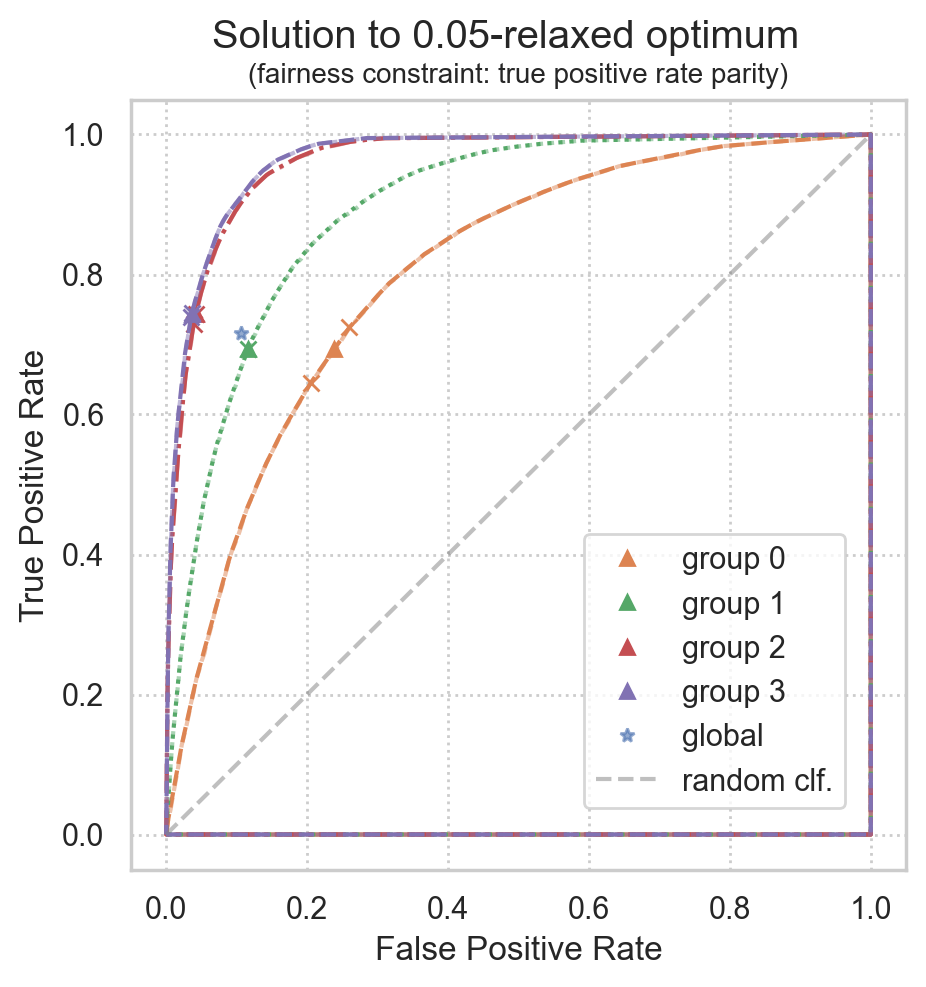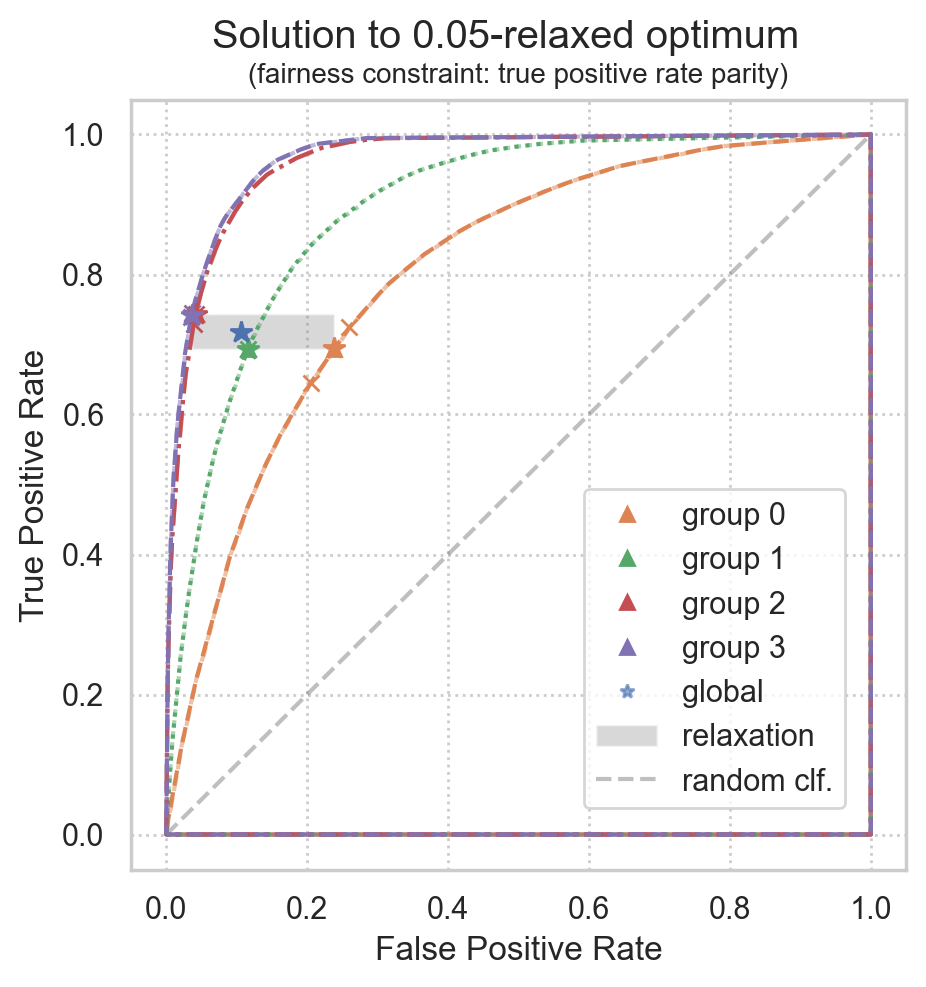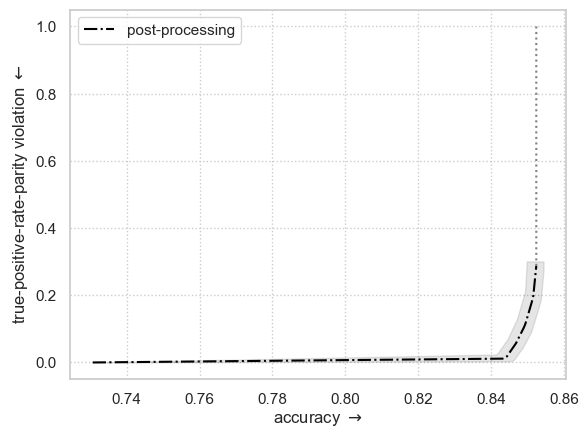Achieving different fairness constraints on synthetic data
The constraint kwarg can take any of the following values:
`"equalized_odds"`, `"demographic_parity"`, `"true_positive_rate_parity"`, `"false_positive_rate_parity"`.
Additionally, for constraint="equalized_odds", you can use the l_p_norm kwarg to use a different l-p norm when computing the distance between group ROC points. Default is l_p_norm=np.inf.
NOTE: this notebook has extra requirements, install them with:
pip install "error_parity[dev]"
[1]:
import logging
from itertools import product
import numpy as np
import cvxpy as cp
from scipy.spatial import ConvexHull
from sklearn.metrics import roc_curve
[2]:
from error_parity import __version__
print(f"Notebook ran using `error-parity=={__version__}`")
Notebook ran using `error-parity==0.3.11`
NOTE: change the FAIRNESS_CONSTRAINT to your target fairness constraint.
[3]:
FAIRNESS_CONSTRAINT = "true_positive_rate_parity"
# FAIRNESS_CONSTRAINT = "false_positive_rate_parity"
# FAIRNESS_CONSTRAINT = "demographic_parity"
# FAIRNESS_CONSTRAINT = "equalized_odds"
Given some data (X, Y, S)
[4]:
def generate_synthetic_data(n_samples: int, n_groups: int, prevalence: float, seed: int):
"""Helper to generate synthetic features/labels/predictions."""
# Construct numpy rng
rng = np.random.default_rng(seed)
# Different levels of gaussian noise per group (to induce some inequality in error rates)
group_noise = [0.1 + 0.4 * rng.random() / (1+idx) for idx in range(n_groups)]
# Generate predictions
assert 0 < prevalence < 1
y_score = rng.random(size=n_samples)
# Generate labels
# - define which samples belong to each group
# - add different noise levels for each group
group = rng.integers(low=0, high=n_groups, size=n_samples)
y_true = np.zeros(n_samples)
for i in range(n_groups):
group_filter = group == i
y_true_groupwise = ((
y_score[group_filter] +
rng.normal(size=np.sum(group_filter), scale=group_noise[i])
) > (1-prevalence)).astype(int)
y_true[group_filter] = y_true_groupwise
### Generate features: just use the sample index
# As we already have the y_scores, we can construct the features X
# as the index of each sample, so we can construct a classifier that
# simply maps this index to our pre-generated predictions for this clf.
X = np.arange(len(y_true)).reshape((-1, 1))
return X, y_true, y_score, group
Generate synthetic data and synthetic predictions (there’s no need to train a predictor, the predictor is seen as a black-box that outputs scores).
[5]:
N_GROUPS = 4
# N_GROUPS = 3
# N_SAMPLES = 1_000_000
N_SAMPLES = 100_000
SEED = 23
X, y_true, y_score, group = generate_synthetic_data(
n_samples=N_SAMPLES,
n_groups=N_GROUPS,
prevalence=0.25,
seed=SEED)
[6]:
actual_prevalence = np.sum(y_true) / len(y_true)
print(f"Actual global prevalence: {actual_prevalence:.1%}")
Actual global prevalence: 26.9%
[7]:
EPSILON_TOLERANCE = 0.05
# EPSILON_TOLERANCE = 1.0 # best unconstrained classifier
FALSE_POS_COST = 1
FALSE_NEG_COST = 1
Given a trained predictor (that outputs real-valued scores)
[8]:
# Example predictor that predicts the synthetically produced scores above
predictor = lambda idx: y_score[idx].ravel()
Construct the fair optimal classifier (derived from the given predictor)
Fairness is measured by the equal odds constraint (equal FPR and TPR among groups);
optionally, this constraint can be relaxed by some small tolerance;
Optimality is measured as minimizing the expected loss,
parameterized by the given cost of false positive and false negative errors;
[9]:
from error_parity import RelaxedThresholdOptimizer
clf = RelaxedThresholdOptimizer(
predictor=predictor,
constraint=FAIRNESS_CONSTRAINT,
tolerance=EPSILON_TOLERANCE,
false_pos_cost=FALSE_POS_COST,
false_neg_cost=FALSE_NEG_COST,
max_roc_ticks=100,
seed=SEED,
)
[10]:
%%time
import logging
logging.basicConfig(level=logging.INFO, force=True)
clf.fit(X=X, y=y_true, group=group)
INFO:root:ROC convex hull contains 36.6% of the original points.
INFO:root:ROC convex hull contains 41.6% of the original points.
INFO:root:ROC convex hull contains 36.6% of the original points.
INFO:root:ROC convex hull contains 38.6% of the original points.
INFO:root:cvxpy solver took 0.000282458s; status is optimal.
INFO:root:Optimal solution value: 0.15335531408011688
INFO:root:Variable Global ROC point: value [0.10552007 0.71687162]
INFO:root:Variable ROC point for group 0: value [0.23852472 0.69338557]
INFO:root:Variable ROC point for group 1: value [0.11605835 0.69338557]
INFO:root:Variable ROC point for group 2: value [0.04159198 0.74338557]
INFO:root:Variable ROC point for group 3: value [0.03632111 0.74338557]
CPU times: user 152 ms, sys: 9 ms, total: 161 ms
Wall time: 242 ms
[10]:
<error_parity.threshold_optimizer.RelaxedThresholdOptimizer at 0x12b1a5db0>
Plot solution
[11]:
from matplotlib import pyplot as plt
import seaborn as sns
sns.set(style="whitegrid", rc={'grid.linestyle': ':'})
[12]:
from error_parity.plotting import plot_postprocessing_solution
plot_postprocessing_solution(
postprocessed_clf=clf,
plot_roc_curves=True,
plot_roc_hulls=True,
dpi=200, figsize=(5, 5),
)
plt.show()

Plot realized ROC points
realized ROC points will converge to the theoretical solution for larger datasets, but some variance is expected for smaller datasets
[13]:
# Set group-wise colors and global color
palette = sns.color_palette(n_colors=N_GROUPS + 1)
global_color = palette[0]
all_group_colors = palette[1:]
[14]:
from error_parity.plotting import plot_postprocessing_solution
from error_parity.roc_utils import compute_roc_point_from_predictions
plot_postprocessing_solution(
postprocessed_clf=clf,
plot_roc_curves=True,
plot_roc_hulls=True,
dpi=200, figsize=(5, 5),
plot_relaxation=True,
)
# Compute predictions
y_pred_binary = clf(X, group=group)
# Plot the group-wise points found
realized_roc_points = list()
for idx in range(N_GROUPS):
# Evaluate triangulation of target point as a randomized clf
group_filter = group == idx
curr_realized_roc_point = compute_roc_point_from_predictions(y_true[group_filter], y_pred_binary[group_filter])
realized_roc_points.append(curr_realized_roc_point)
plt.plot(
curr_realized_roc_point[0], curr_realized_roc_point[1],
color=all_group_colors[idx],
marker="*", markersize=8,
lw=0,
)
realized_roc_points = np.vstack(realized_roc_points)
# Plot actual global classifier performance
global_clf_realized_roc_point = compute_roc_point_from_predictions(y_true, y_pred_binary)
plt.plot(
global_clf_realized_roc_point[0], global_clf_realized_roc_point[1],
color=global_color,
marker="*", markersize=8,
lw=0,
)
plt.show()

Compute distances between theorized ROC points and empirical ROC points
[15]:
# Distances to group-wise targets:
for i, (target_point, actual_point) in enumerate(zip(clf.groupwise_roc_points, realized_roc_points)):
dist = np.linalg.norm(target_point - actual_point, ord=2)
print(f"Group {i}: l2 distance from target to realized point := {dist:.3%}")
# Distance to global target point:
dist = np.linalg.norm(clf.global_roc_point - global_clf_realized_roc_point, ord=2)
print(f"Global l2 distance from target to realized point := {dist:.3%}")
Group 0: l2 distance from target to realized point := 0.199%
Group 1: l2 distance from target to realized point := 0.000%
Group 2: l2 distance from target to realized point := 0.003%
Group 3: l2 distance from target to realized point := 0.092%
Global l2 distance from target to realized point := 0.036%
Compute performance differences
assumes FP_cost == FN_cost == 1.0
[16]:
from sklearn.metrics import accuracy_score
from error_parity.roc_utils import calc_cost_of_point
# Empirical
accuracy_val = accuracy_score(y_true, y_pred_binary)
# Theoretical
theoretical_global_cost = calc_cost_of_point(
fpr=clf.global_roc_point[0],
fnr=1 - clf.global_roc_point[1],
prevalence=y_true.sum() / len(y_true),
)
print(f"Actual accuracy: \t\t\t{accuracy_val:.3%}")
print(f"Actual error rate (1 - Acc.):\t\t{1 - accuracy_val:.3%}")
print(f"Theoretical cost of solution found:\t{theoretical_global_cost:.3%}")
Actual accuracy: 84.678%
Actual error rate (1 - Acc.): 15.322%
Theoretical cost of solution found: 15.336%
Compute empirical fairness violation
[17]:
from error_parity.evaluation import evaluate_fairness
empirical_metrics = evaluate_fairness(
y_true=y_true,
y_pred=y_pred_binary,
sensitive_attribute=group,
)
disparity_metric_map = {
"equalized_odds": "equalized_odds_diff",
"true_positive_rate_parity": "tpr_diff",
"false_negative_rate_parity": "tpr_diff",
"false_positive_rate_parity": "fpr_diff",
"true_negative_rate_parity": "fpr_diff",
"demographic_parity": "ppr_diff",
}
disparity_metric = disparity_metric_map[FAIRNESS_CONSTRAINT]
# Calculate empirical fairness violation
empirical_constraint_violation = empirical_metrics[disparity_metric]
# Check if empirical and theoretical results are reasonably close
print(f"Empirical {FAIRNESS_CONSTRAINT} violation: {empirical_constraint_violation:.3}")
print(f"Theoretical {FAIRNESS_CONSTRAINT} violation: {clf.constraint_violation():.3}")
print(f"Max theoretical constraint violation:\t {clf.tolerance:.3}")
INFO:root:Maximum fairness violation is between group=0 (p=[0.69338557]) and group=2 (p=[0.74338557]);
Empirical true_positive_rate_parity violation: 0.05
Theoretical true_positive_rate_parity violation: 0.05
Max theoretical constraint violation: 0.05
Plot Fairness-Accuracy Pareto frontier achievable by postprocessing
[18]:
from error_parity.pareto_curve import compute_postprocessing_curve
postproc_results_df = compute_postprocessing_curve(
model=predictor,
fit_data=(X, y_true, group),
eval_data={
"fit": (X, y_true, group),
},
fairness_constraint=FAIRNESS_CONSTRAINT,
predict_method="__call__", # for callable predictors
bootstrap=True,
seed=SEED,
)
INFO:root:Using `n_jobs=9` to compute adjustment curve.
INFO:root:Computing postprocessing for the following constraint tolerances: [0. 0.01 0.02 0.03 0.04 0.05 0.06 0.07 0.08 0.09 0.1 0.11 0.12 0.13
0.14 0.15 0.16 0.17 0.18 0.19 0.2 0.3 0.4 0.5 0.6 0.7 0.8 0.9 ].
[19]:
from error_parity.plotting import plot_postprocessing_frontier
plot_postprocessing_frontier(
postproc_results_df,
perf_metric="accuracy",
disp_metric=disparity_metric,
show_data_type="fit", # synthetic data example on the same data as used to fit the model
constant_clf_perf=max((y_true == const_pred).mean() for const_pred in {0, 1}),
)
plt.xlabel(r"accuracy $\rightarrow$")
plt.ylabel(FAIRNESS_CONSTRAINT.replace("_", "-") + r" violation $\leftarrow$")
plt.show()
